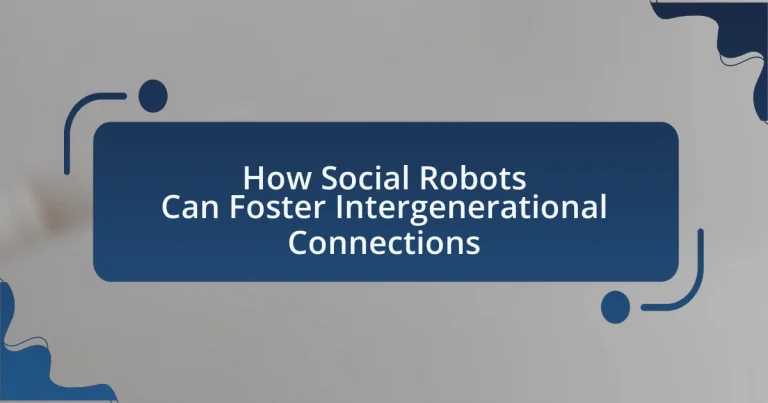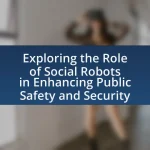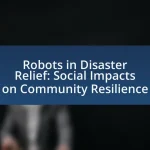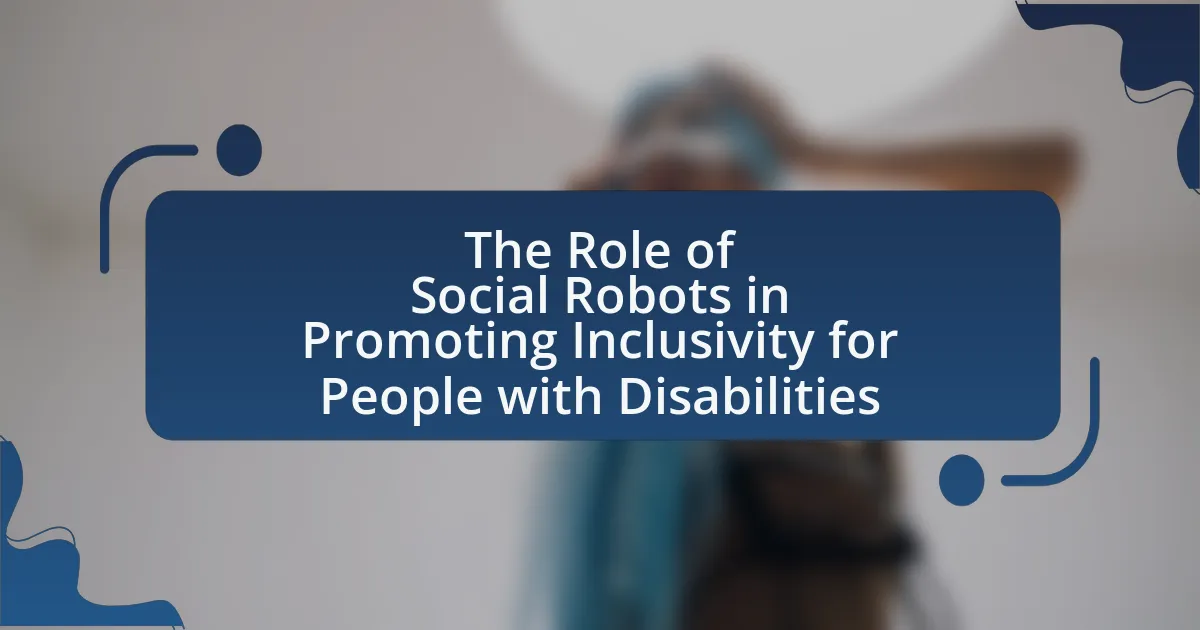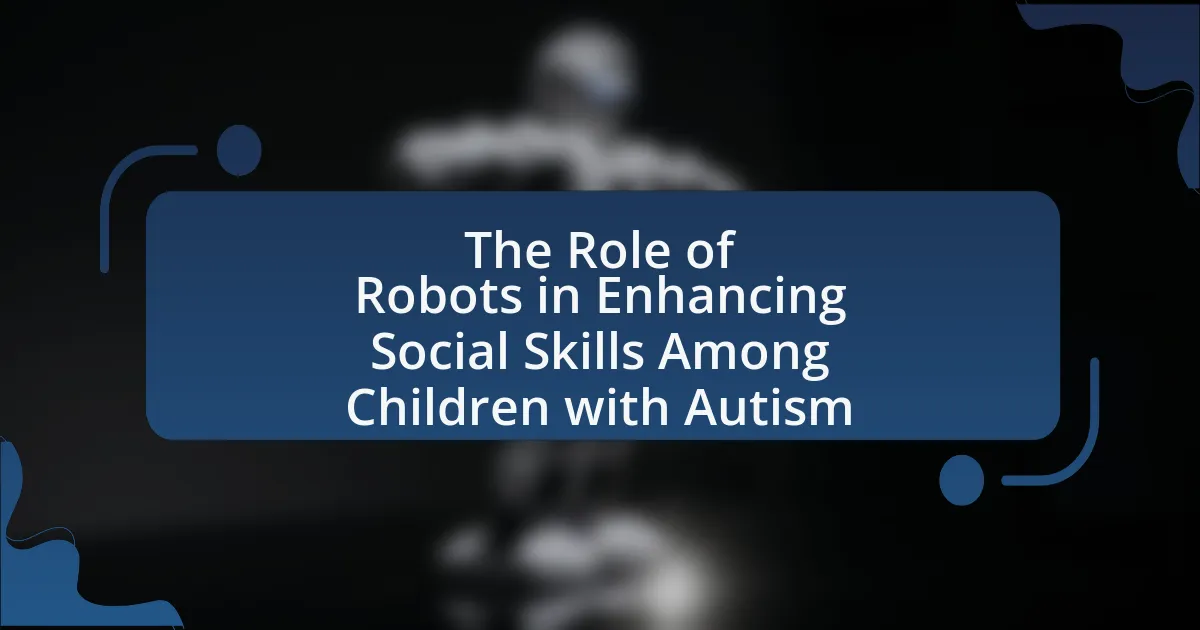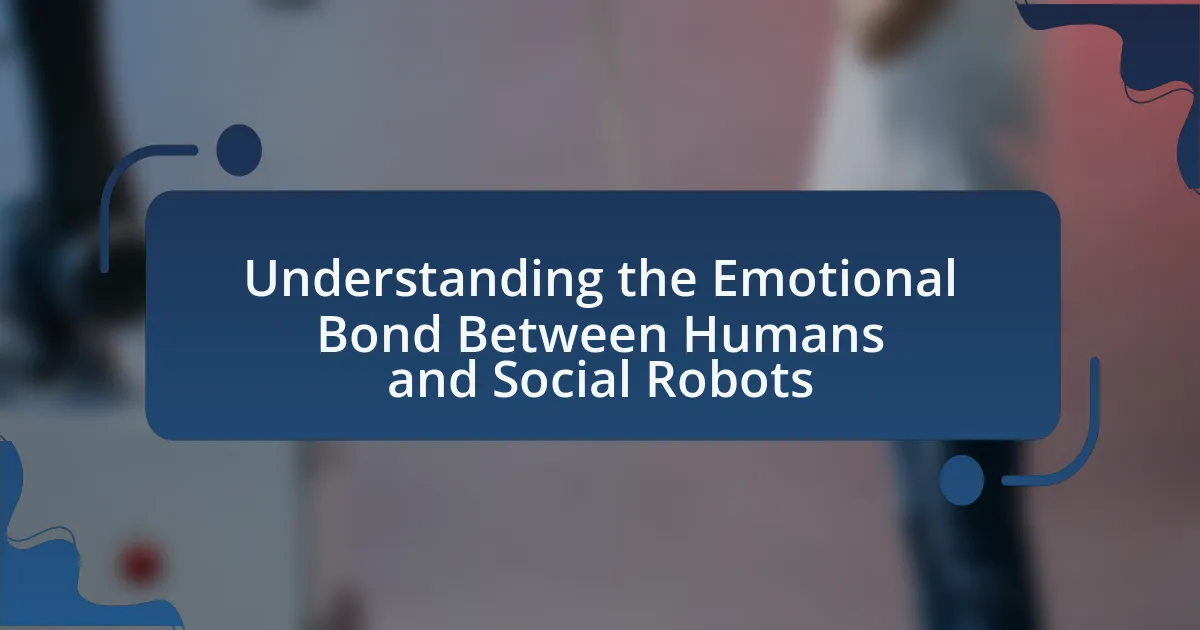Social robots are autonomous machines designed to interact with humans in social contexts, playing a significant role in fostering intergenerational connections. They facilitate communication and shared activities between different age groups, enhancing social interaction and reducing feelings of loneliness, particularly among seniors. The article explores how social robots, equipped with technologies like natural language processing and emotional recognition, can effectively engage both children and older adults through tailored interactions, collaborative tasks, and emotional support. It also addresses the challenges in fostering these connections, such as communication barriers and societal perceptions, while highlighting the benefits of intergenerational relationships for community well-being and individual emotional health.

How can social robots foster intergenerational connections?
Social robots can foster intergenerational connections by facilitating communication and shared activities between different age groups. These robots can engage seniors and children in interactive games, storytelling, and educational tasks, which promote collaboration and understanding. For instance, studies have shown that social robots like NAO and Pepper have been successfully used in educational settings to bridge the gap between elderly individuals and younger generations, enhancing social interaction and reducing feelings of loneliness among seniors. Additionally, the use of robots in family settings has been linked to improved emotional bonds, as they provide a platform for shared experiences and learning opportunities, thereby strengthening intergenerational relationships.
What are social robots and their roles in society?
Social robots are autonomous machines designed to interact with humans in a social context, often equipped with artificial intelligence to facilitate communication and emotional engagement. Their roles in society include providing companionship, assisting in caregiving, enhancing education, and promoting social interaction among diverse age groups. For instance, studies have shown that social robots can significantly improve the quality of life for elderly individuals by reducing feelings of loneliness and enhancing emotional well-being. Research conducted by the University of Southern California found that social robots like PARO, a therapeutic robot seal, can effectively reduce anxiety and improve mood in elderly care settings.
How do social robots interact with different age groups?
Social robots interact with different age groups by adapting their communication styles and functionalities to meet the specific needs and preferences of each demographic. For example, children often engage with social robots through play and educational activities, benefiting from interactive storytelling and games that enhance learning. In contrast, older adults may prefer companionship and assistance, with robots providing reminders for medication or facilitating social interaction to combat loneliness. Research indicates that children are more likely to respond positively to robots that exhibit playful behaviors, while older adults appreciate robots that demonstrate empathy and understanding, as shown in studies like “The Role of Social Robots in Intergenerational Interaction” by K. K. Kahn et al. (2015), which highlights the effectiveness of tailored interactions in fostering connections across age groups.
What technologies enable social robots to communicate effectively?
Social robots communicate effectively through technologies such as natural language processing (NLP), speech recognition, and machine learning. NLP allows robots to understand and generate human language, enabling them to engage in meaningful conversations. Speech recognition technology helps robots accurately interpret spoken language, facilitating real-time interaction. Machine learning algorithms enhance a robot’s ability to learn from interactions, improving its responses over time. These technologies collectively enable social robots to adapt to user preferences and provide personalized communication, which is essential for fostering intergenerational connections.
Why are intergenerational connections important?
Intergenerational connections are important because they enhance social cohesion and promote mutual understanding between different age groups. These connections facilitate the sharing of knowledge, experiences, and cultural values, which can lead to improved emotional well-being and reduced feelings of isolation among older adults. Research indicates that intergenerational interactions can decrease ageism and foster empathy, as evidenced by studies showing that programs involving youth and seniors lead to increased positive attitudes toward aging. Additionally, the National Institute on Aging highlights that such connections can improve the mental health of older adults, as they often experience loneliness and depression when isolated from younger generations.
What benefits do intergenerational relationships provide to individuals?
Intergenerational relationships provide individuals with emotional support, enhanced well-being, and increased social engagement. These relationships foster a sense of belonging and purpose, particularly for older adults, who often experience loneliness. Research indicates that older adults involved in intergenerational interactions report higher levels of happiness and lower levels of depression. Additionally, younger individuals benefit from the wisdom and life experiences shared by older generations, which can enhance their problem-solving skills and emotional intelligence. Studies show that such relationships can lead to improved cognitive functioning in seniors and greater empathy in youth, demonstrating the reciprocal benefits of these connections.
How do these connections impact community well-being?
Connections fostered by social robots significantly enhance community well-being by promoting social interaction and reducing feelings of isolation among different age groups. Research indicates that intergenerational connections facilitated by technology can lead to improved mental health outcomes, as evidenced by a study published in the Journal of Gerontology, which found that older adults who engaged with younger individuals reported lower levels of depression and increased life satisfaction. Furthermore, these connections can enhance community cohesion, as they encourage collaboration and understanding between generations, ultimately leading to a more supportive and resilient community environment.
What challenges exist in fostering intergenerational connections?
Fostering intergenerational connections faces several challenges, including communication barriers, differing values, and technological gaps. Communication barriers arise from generational differences in language and expression, making it difficult for individuals from different age groups to understand each other. Differing values often stem from varying life experiences and cultural contexts, leading to misunderstandings and conflicts. Additionally, technological gaps can hinder interactions, as younger generations may be more adept at using digital tools, while older individuals may struggle with technology, limiting their ability to engage meaningfully. These challenges can impede the development of strong intergenerational relationships, highlighting the need for targeted strategies to bridge these gaps.
How do societal perceptions affect interactions between generations?
Societal perceptions significantly influence interactions between generations by shaping attitudes, expectations, and communication styles. For instance, stereotypes about older adults being technologically inept can lead younger generations to underestimate their capabilities, resulting in less engagement and fewer collaborative opportunities. Research indicates that positive intergenerational perceptions can enhance mutual respect and understanding, fostering more meaningful interactions. A study published in the Journal of Intergenerational Relationships found that when younger individuals view older adults as valuable contributors, it leads to increased social interaction and collaboration, demonstrating the impact of societal perceptions on generational dynamics.
What barriers do older adults face in engaging with younger generations?
Older adults face several barriers in engaging with younger generations, including technological gaps, social isolation, and generational differences in communication styles. The rapid advancement of technology often leaves older adults feeling disconnected, as they may lack familiarity with digital platforms commonly used by younger individuals. Additionally, social isolation can limit opportunities for interaction, as many older adults may live alone or in environments that do not facilitate intergenerational engagement. Furthermore, differences in communication preferences, such as younger generations favoring informal and fast-paced interactions, can create misunderstandings and hinder meaningful connections. These barriers collectively contribute to the challenges older adults experience in fostering relationships with younger individuals.
How do social robots address these challenges?
Social robots address challenges in fostering intergenerational connections by providing companionship, facilitating communication, and enhancing engagement among different age groups. These robots are designed to interact with users through natural language processing and emotional recognition, which helps bridge the gap between generations. For instance, studies have shown that social robots can reduce feelings of loneliness in older adults by offering consistent interaction and companionship, thereby improving their emotional well-being. Additionally, social robots can assist in teaching technology to younger generations, promoting mutual understanding and collaboration. Research indicates that these interactions can lead to improved social skills and cognitive engagement for both older and younger users, demonstrating the effectiveness of social robots in overcoming barriers to intergenerational connections.
What specific features of social robots enhance intergenerational engagement?
Social robots enhance intergenerational engagement through features such as emotional recognition, interactive communication, and personalized content delivery. Emotional recognition allows robots to identify and respond to the feelings of users, fostering a sense of connection and empathy. Interactive communication capabilities enable robots to engage users in conversations, promoting social interaction and reducing feelings of isolation among older adults. Additionally, personalized content delivery, which tailors activities and information to individual preferences, encourages participation and keeps users engaged. Research indicates that these features significantly improve the quality of interactions between different age groups, thereby strengthening intergenerational bonds.
How do social robots facilitate communication between generations?
Social robots facilitate communication between generations by providing interactive platforms that engage users of different ages in meaningful dialogue. These robots utilize natural language processing and adaptive learning algorithms to tailor conversations, making them accessible and relevant to both younger and older individuals. Research indicates that social robots can reduce barriers to communication, such as social anxiety or technological unfamiliarity, by offering a non-judgmental and patient interface. For instance, studies have shown that older adults interacting with social robots report increased feelings of companionship and improved communication skills, which enhances their ability to connect with younger generations.
What activities can social robots promote to encourage interaction?
Social robots can promote activities such as games, storytelling, and collaborative tasks to encourage interaction. These activities facilitate engagement by providing shared experiences that can bridge generational gaps. For instance, research has shown that playing interactive games with social robots can enhance communication and social skills among older adults and children alike, fostering a sense of companionship and reducing feelings of isolation. Additionally, storytelling sessions led by social robots can stimulate cognitive engagement and emotional connection, making interactions more meaningful. Collaborative tasks, such as arts and crafts facilitated by robots, can also promote teamwork and creativity, further enhancing intergenerational relationships.
What evidence supports the effectiveness of social robots in fostering connections?
Social robots have been shown to effectively foster connections, particularly in intergenerational contexts. Research conducted by Sherry Turkle at MIT highlights that social robots can enhance communication and emotional engagement between older adults and younger generations, leading to improved social interactions. A study published in the journal “Gerontechnology” by researchers from the University of Southern California found that interactions with social robots significantly reduced feelings of loneliness among elderly participants, demonstrating their potential to bridge generational gaps. Additionally, a systematic review in “Frontiers in Robotics and AI” by authors including M. A. K. Alenazi indicates that social robots can facilitate meaningful conversations and emotional support, further reinforcing their role in fostering connections across age groups.
What studies have been conducted on social robots and intergenerational relationships?
Studies on social robots and intergenerational relationships have demonstrated their potential to enhance communication and emotional connections between different age groups. For instance, a study by Kory and Breazeal (2014) titled “Social Robots for Intergenerational Learning” published in the journal “International Journal of Social Robotics” found that social robots can facilitate interactions between children and elderly individuals, promoting mutual understanding and engagement. Another significant study by Robins et al. (2009) in “Interaction Studies” explored how social robots can serve as companions for older adults, reducing feelings of loneliness and fostering social interaction with younger generations. These studies provide concrete evidence that social robots can effectively bridge the gap between generations, enhancing intergenerational relationships.
How do user experiences reflect the impact of social robots?
User experiences reflect the impact of social robots by demonstrating enhanced emotional engagement and improved social interactions among users. Research indicates that social robots can facilitate communication and connection, particularly in intergenerational settings, where older adults report feeling less isolated and more engaged when interacting with robots. For instance, a study published in the journal “Gerontechnology” by K. K. K. Lee and colleagues found that older adults using social robots experienced increased feelings of companionship and reduced loneliness, highlighting the robots’ role in fostering meaningful relationships. This evidence underscores how user experiences with social robots can significantly influence emotional well-being and social connectivity.
What are best practices for implementing social robots in intergenerational settings?
Best practices for implementing social robots in intergenerational settings include ensuring user-friendly interfaces, fostering emotional connections, and providing tailored interactions. User-friendly interfaces are crucial as they facilitate ease of use for both younger and older generations, enhancing engagement. Fostering emotional connections can be achieved through programming robots to recognize and respond to human emotions, which has been shown to improve user satisfaction and interaction quality. Tailored interactions, based on the specific needs and preferences of different age groups, can enhance the relevance and effectiveness of the robot’s role in facilitating communication and activities. Research indicates that these practices lead to increased acceptance and positive experiences with social robots across generations, as evidenced by studies demonstrating improved social engagement and reduced feelings of loneliness among older adults when interacting with robots designed for intergenerational use.
How can caregivers and educators effectively integrate social robots?
Caregivers and educators can effectively integrate social robots by incorporating them into daily routines and educational activities to enhance engagement and interaction. For instance, social robots can be used to facilitate communication between generations, such as having children interact with elderly individuals through guided conversations or games, which has been shown to improve social skills and emotional well-being. Research indicates that programs utilizing social robots in educational settings have led to increased motivation and participation among students, as evidenced by a study published in the journal “Robotics and Autonomous Systems” by authors K. K. Kahn et al., which found that children exhibited higher levels of interest and learning retention when interacting with robots. By strategically embedding social robots into structured activities, caregivers and educators can create meaningful intergenerational connections that benefit both young and older participants.
What considerations should be made for different age groups when using social robots?
When using social robots, considerations for different age groups include cognitive abilities, emotional needs, and social interaction preferences. For children, robots should be designed to engage through play and education, utilizing simple interfaces and interactive features that promote learning and creativity. Research indicates that children respond positively to robots that exhibit playful behaviors, enhancing their learning experiences (Breazeal, 2002).
For adults, particularly those in middle age, social robots can serve as companions or assistants, focusing on practical functionalities such as reminders and communication aids. Studies show that adults appreciate robots that can facilitate social connections and provide support in daily tasks (Fong et al., 2003).
For the elderly, considerations should prioritize ease of use, emotional support, and companionship. Robots designed for older adults should feature intuitive controls and be capable of recognizing and responding to emotional cues, as this demographic often seeks social interaction to combat loneliness (Sharkey & Sharkey, 2012). Overall, tailoring social robots to meet the specific needs of each age group enhances their effectiveness and fosters intergenerational connections.
What future developments can enhance the role of social robots in intergenerational connections?
Future developments that can enhance the role of social robots in intergenerational connections include advancements in artificial intelligence, emotional recognition, and personalized interaction capabilities. These technologies will enable robots to better understand and respond to the emotional states and preferences of users across different age groups, fostering deeper connections. For instance, AI algorithms that analyze speech patterns and facial expressions can help robots tailor their interactions, making them more engaging for both younger and older individuals. Research indicates that robots equipped with emotional intelligence can significantly improve user satisfaction and social engagement, as seen in studies conducted by the University of Southern California, which found that emotionally responsive robots increased interaction quality among diverse age groups.
How might advancements in AI improve social robot interactions?
Advancements in AI can significantly enhance social robot interactions by enabling more natural and intuitive communication. Improved natural language processing allows robots to understand and respond to human emotions and context, fostering deeper connections. For instance, AI algorithms can analyze speech patterns and emotional cues, leading to more empathetic responses. Research indicates that robots equipped with advanced AI can adapt their behavior based on user interactions, which enhances user engagement and satisfaction. This adaptability is crucial for intergenerational connections, as it allows robots to cater to the unique communication styles of different age groups, thereby promoting meaningful interactions.
What potential innovations could further bridge generational gaps?
Potential innovations that could further bridge generational gaps include the development of advanced social robots designed for intergenerational interaction. These robots can facilitate communication and shared activities between different age groups, enhancing understanding and reducing stereotypes. For instance, research has shown that social robots like Jibo and Pepper can engage users in conversation, play games, and even assist with learning, making them effective tools for fostering connections. A study published in the journal “Gerontechnology” demonstrated that interactions with social robots improved social engagement among older adults, highlighting their potential to bridge generational divides.
What practical tips can help maximize the benefits of social robots in fostering intergenerational connections?
To maximize the benefits of social robots in fostering intergenerational connections, it is essential to ensure that the robots are designed with user-friendly interfaces that cater to both younger and older users. This includes incorporating intuitive controls and engaging features that appeal to diverse age groups. Research indicates that when social robots are equipped with interactive storytelling capabilities, they can effectively bridge communication gaps, enhancing engagement between generations. For instance, studies have shown that robots like Jibo and Pepper can facilitate conversations and shared activities, leading to improved emotional connections and reduced feelings of isolation among older adults. Additionally, regular training sessions for both age groups on how to use these robots can further enhance their effectiveness, as familiarity with technology often correlates with increased usage and satisfaction.
